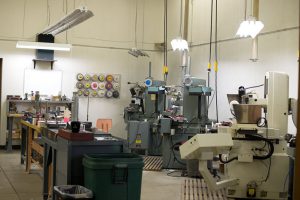 When you want to cut or shape metal to your required specifications, you will need to use metalworking machine tools called stamping presses. In this process, the metal is drawn, trimmed, formed, blanked, and/or pierced with a die. This process can typically be used for metal that is in sheet or coil form.
When you want to cut or shape metal to your required specifications, you will need to use metalworking machine tools called stamping presses. In this process, the metal is drawn, trimmed, formed, blanked, and/or pierced with a die. This process can typically be used for metal that is in sheet or coil form.
A stamping press is made up of a ram and a bolster plate. The process of stamping requires the forming of the metal that is placed between the two halves that make up the press tool. The upper member remains attached to the slides on the press, while the lower member is fixed to the bolster plate (or bed) that remains stationary. Larger presses can have die cushions that are an integral part of the bolster plate and help in the application of blank holder forces.
Single-Acting v/s Double-Acting Presses
Presses that are single-acting will have a single ram, while a sub-divided ram is used in double-acting presses. The ram remains clamped to the upper part of the stamping die. The ram is responsible for generating the up and down movement when metal is introduced through the die on the press. When the metal is in coil form, it has to first go through a straightener. Metal can be shaped to any form once it is cut. Shear occurs when metal is pierced with a snap-through.
Mechanically Driven Presses
Presses can be driven both hydraulically and mechanically. Eccentric drives are used on mechanical presses, while hydraulic cylinders are used for moving the ram up and down in hydraulic presses. Mechanical presses have flywheels that obtain power from a motor. Kinetic energy gets stored in the flywheel that turns the wheel downward till it reaches the plate. Mechanical presses operate steadily and make the production of metal products easy in an assembly-style environment. You will find their use common in industrial press shops because they allow higher cycles to be carried out in a unit of time.
Hydraulically Driven Presses
In a hydraulic press, the force of the press during a stroke remains constant, while in mechanical presses the pressing force increases progressively. The pressing action in hydraulic presses is guided by the die while air or liquid is used to create the pressure in it.
Many industries, like automotive, aerospace, construction and medical fields use stampings. It is a process that is ideal for high precision and/or high volume jobs. Stamping products need to be shallow and flat in form, will fall typically within an area of 6 inches, and have metal thicknesses can vary from .0005 to.260 off an inch. You can opt for making parts that are customized according to your needs. Whether you need a stamping press that is a basic metal one, or something more intricate any specialty manufacturer that you choose, should be able to meet your needs. The stamping process can create the exact size and shape of the metal that you need. Based on the needs for your industry or project, you can choose from a wide variety of stamping press types. Any equipment like a mechanical stamping press will have problems and requires it to be maintained adequately so that the press always meets the tolerances that are needed. The press will have normal wear and tear, and its parts need frequent checking and replacement. Presses are machinery that can be repaired, restructured or rebuilt if needed.





